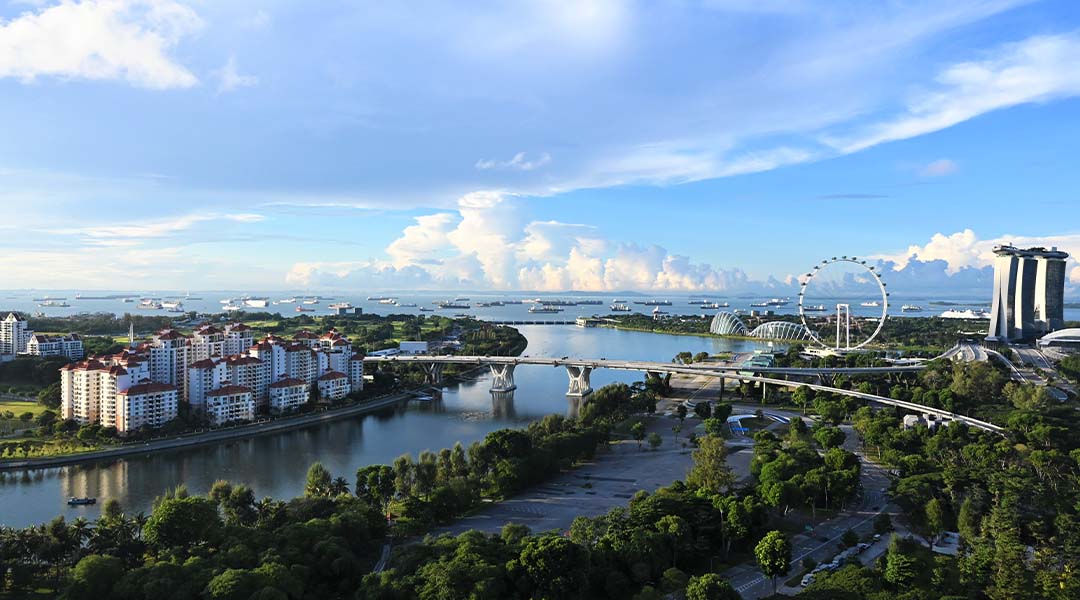
Industry experts advise clients on their next move towards a pandemic-ready world
“So my last slide is about a challenge to everyone, and maybe a question: Are we setting up our companies just to survive? Or are we looking at redefining the way we do work, the way we advise our clients so that both consultants and clients have new opportunities to thrive in these trying times?” AIDEA CEO Jojo Tolentino asked the audience as he concluded his presentation for the first live session of ‘Build a Better Normal,’ the three-part LIXIL Design DeepDive™ Live Sessions – Philippines.

READ MORE: Are you ready to build a better normal?
The first edition of the live sessions, ‘Advising Clients in a Brave New World,’ focused on providing strategies for guiding clients and stakeholders towards innovative business and design solutions for a safer, pandemic-ready world. Participants who registered via zoom and audiences who tuned in on American Standard Facebook page last July 22, were able to view and listen to the presentations of Tolentino and his fellow speakers Sigrid Zialcita, President and CEO of Asia Pacific Real Estate Association; and Dr. Christine Bruckner, Director of M Moser Associates.
Reactors Toni Vasquez, CEO and Principal Architect of T.I. Vasquez Architects & Planners; Dexter Lee, Managing Director of Luana Lifestyle and Leisure Hotel and co-developer of Lotus Central Mall; and Cherie Fernandez, Vice President for Developments of Federal Land initiated the Q&A, asking about the increased costs for designing healthy, whether more people would favor living in single-detached homes rather than vertical units, examples of existing, not-quite-healthy buildings retrofitted to WELL Building standards.
Five questions from the audience were also answered, opening a discussion on building codes and government initiatives. Each of the speakers delivered their own ways of communicating and connecting with clients, sharing their recipes for best practice and success.
To answer Tolentino’s question, we must revisit the speakers’ presentations.
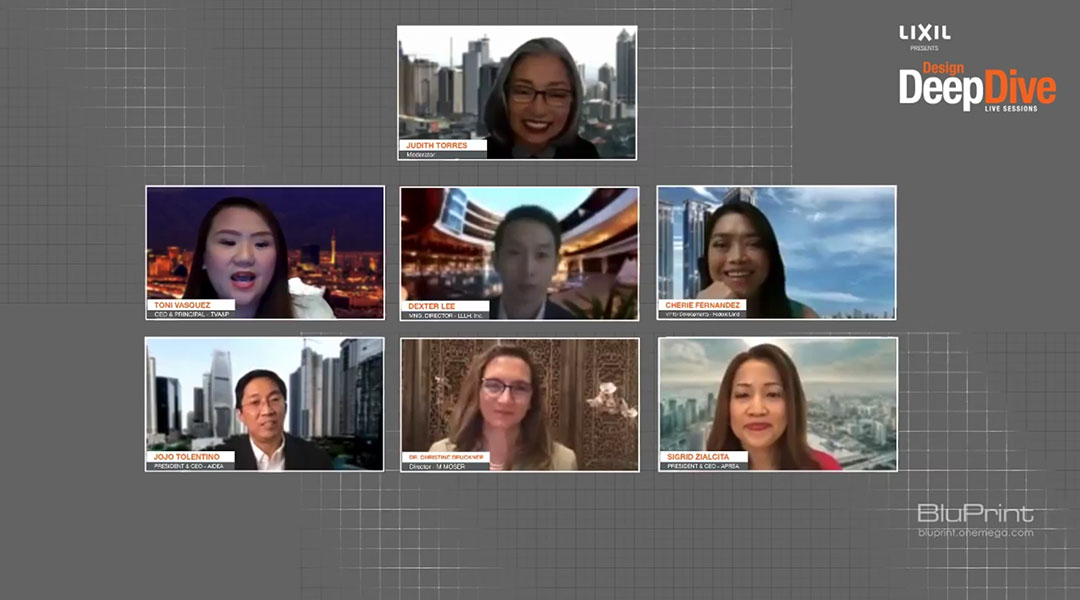
What’s the situation?
Tolentino’s presentation came after APREA CEO Sigrid Zialcita, who laid down “some of the megatrends and the macro environment in which developers and property owners across Asia will be building and operating in the next two to five years.” Zialcita remains optimistic for the Asian economy in spite of the geopolitical risks in the region, citing Asia Pacific as the fastest growing economy in the world and home to the rising middle-class population, as well as the urbanization of Asian nations.
Throughout her presentation, Zialcita underscored the importance of cost discipline, agility, and flexibility of workspaces, technological and digital transformations and solutions, health and wellness, and sustainability in achieving a better normal.

“Now, as global growth will remain subdued, cost discipline will remain imperative. Building owners and tenants will seek to manage operational costs, evade high fit-out expenses, and exert prudent control over capital expenditures,” said Zialcita. “So, how will real estate evolve? With the rise of remote working and the growing reliance on digital collaboration, the modern office can feel a lot less social.”

Zialcita further explained that with technology, there is a greater impetus today to create initiatives to monitor and track data and utilize them to effectively improve building operations, service, and quality of the occupants. “Aside from the extensive use of technology in the workplace, there will be a laser-focus on the health and wellness of employees, tenants, and/or visitors,” she added.
Zialcita also reported that companies will continue to rely on and use sustainable workplaces to boost their sense of purpose and value, which can either be achieved through retrofitting older offices to meet sustainability goals or starting from the ground up.
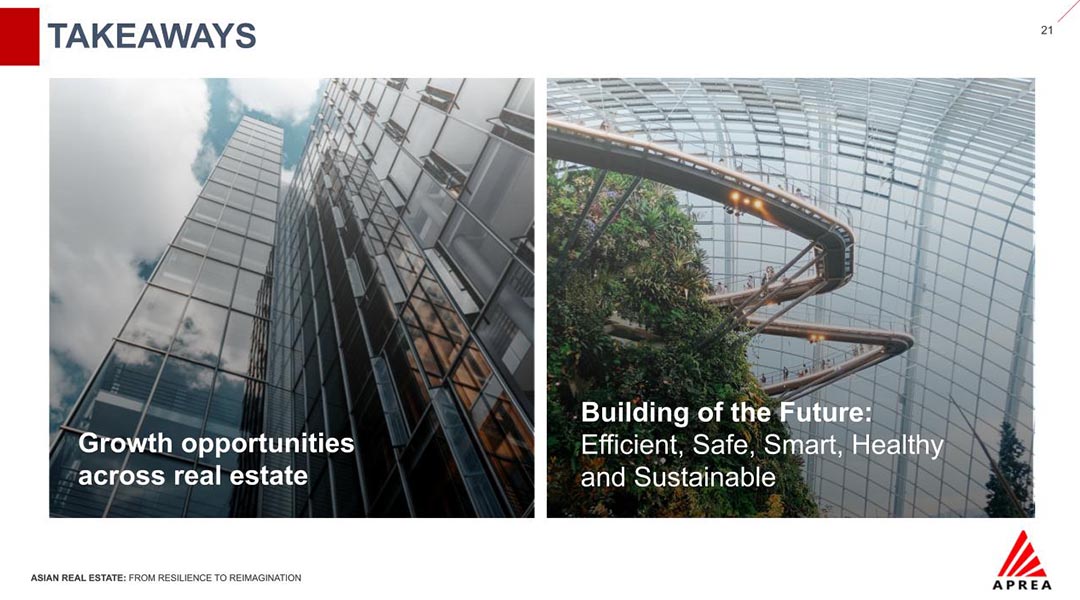
“The Asia Pacific will remain on a growth track and present a ton of great opportunities for real estate, but the challenge for all of us in this business is that we have to make sure that our built environment over the next few years will be efficient, safe, healthy, and sustainable,” Zialcita concluded her presentation.
YOU MIGHT LIKE: Build a Better Normal: Advising Clients in a Brave New World
So, how do you advise clients in a brave new world?
Jojo Tolentino shared the secret sauce to AIDEA’s successful partnerships with their clients in his presentation, ‘Survive or Thrive: Partnering for Success’—connection, innovation, and transformation. “We are a firm that connects, innovates, and transforms into everything we do. In action forms, it has something to do with how we communicate, how we deliver our service, and how we provide the design that is appropriate for a particular client and a particular project,” Tolentino explained.
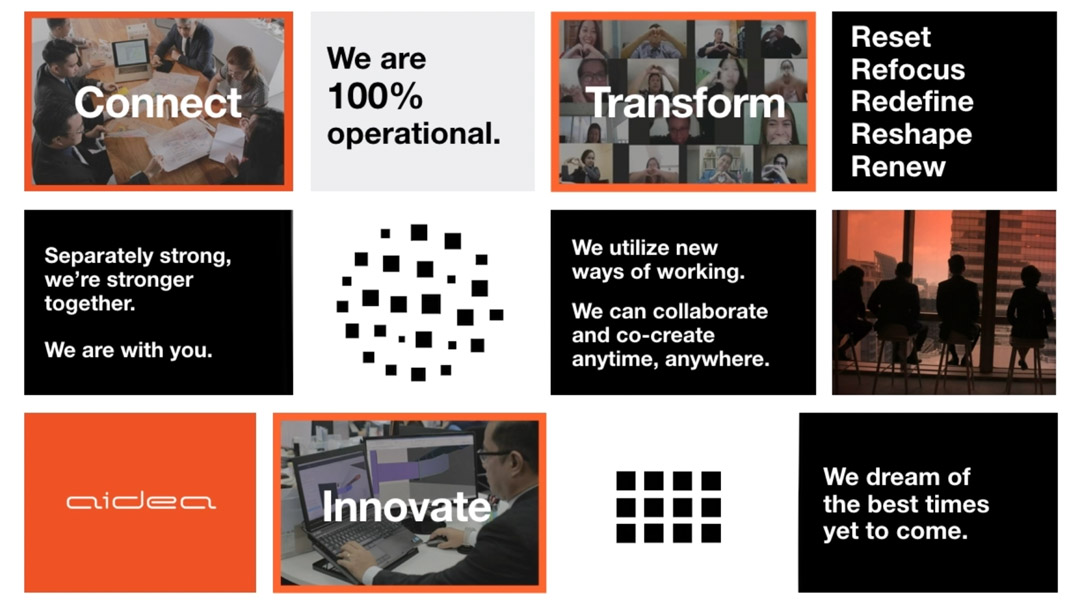
The AIDEA CEO said that these three principles have been the firm’s driving force during the pandemic and that they will continue to apply these moving forward. He said that connecting to both new and existing clients during a crisis situation is crucial. “Providing the stability that even during a crisis situation, we will continue to communicate and look after their interest. It is prime and foremost for us as a business,” Tolentino said. He underscored that strengthening internal connections is a crucial step in connecting well with their clients. While the pandemic pushed their teams to communicate virtually, Tolentino said that they “make sure that we connect, we create activities together, even though we don’t see each other face-to-face and this is the same connection that we have with our clients. We regularly talk to them even if it’s done virtually.” Tolentino emphasized that finding creative ways to connect and develop relationships during the pandemic and reassure clients that projects are moving forward even as work is done remotely are all essential.
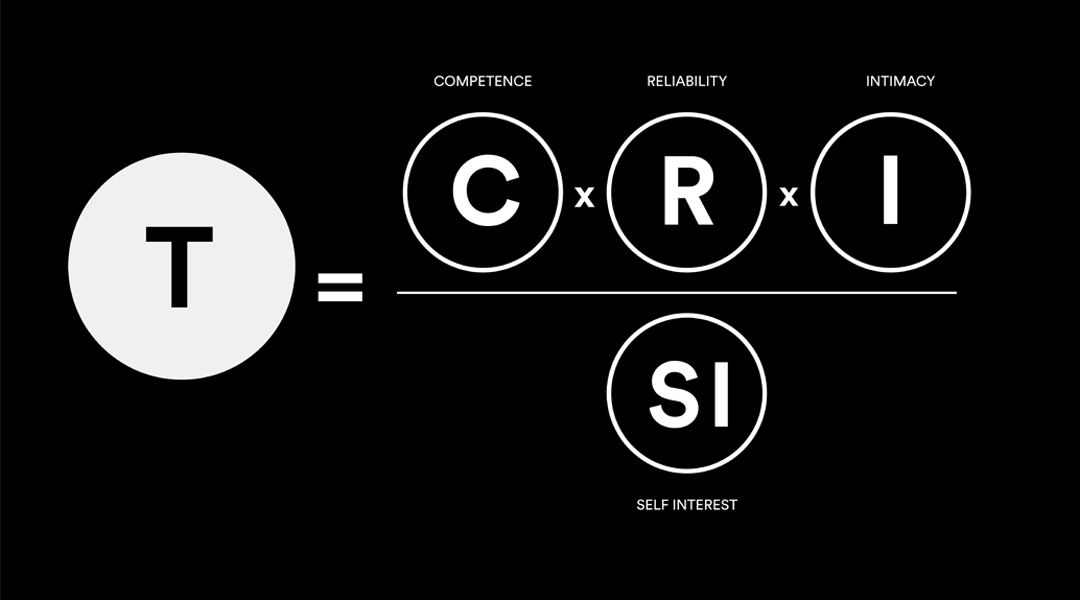
The second component, ‘innovation,’ has a lot to do with what Zialcita said about technology and digital transformation according to Tolentino. Since presentations and collaboration cannot be performed face-to-face, the obvious solution is technology. The architect shared that his firm has shifted to using digital whiteboards and PostIts to present their ideas and collaborate with clients. “The thing about this pandemic and transforming digitally is that clients now have time and they are able to look at projects more closely,” he exclaimed. “Projects have to be available anytime, anywhere. So, the tools that we have enabled our clients to actively be involved in projects wherever they are, as long as they have connectivity.”
Tolentino also shared that they are using virtual reality to their clients to experience projects better. “Most clients like this because they like the idea of seeing projects in almost 1:1 scale in reality, and having the reality and having the ability to control the way they navigate inside projects.” Tolentino pointed out that innovation “has a lot to do with maintaining a creative and collaborative process but doing it digitally.” He explained that this principle is all about making the design process cost-effective and time-efficient, making sure that the spirit of collaboration and creativity is never lost, no matter what the medium is.
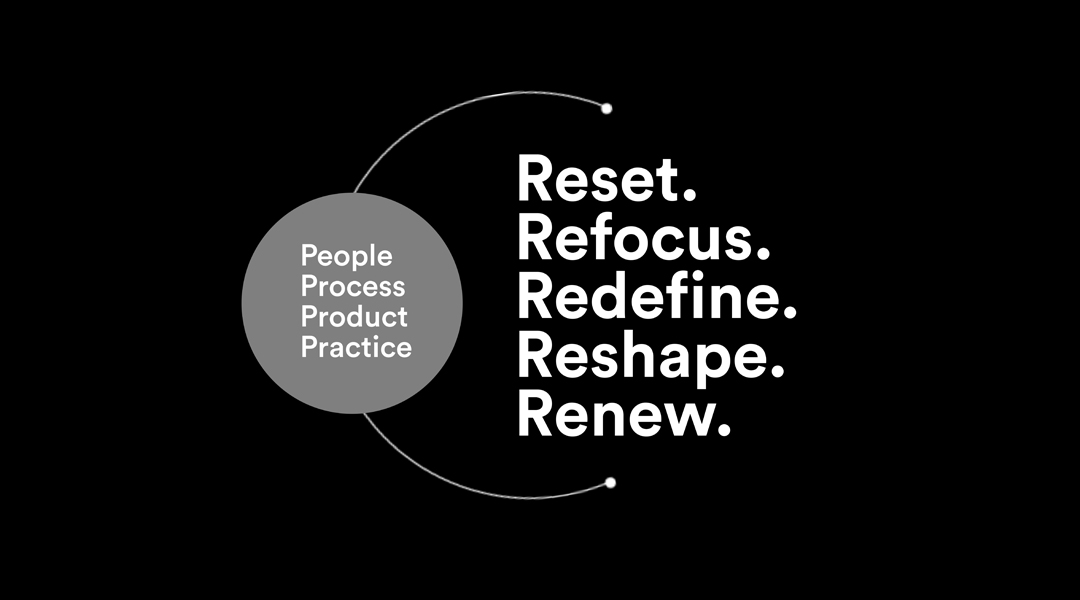
“We have to transform the way we deliver design work and the way we look at design,” Tolentino said as he began discussing the last principle, ‘transformation.’ In the past, the CEO shared that AIDEA’s design had a lot to do with functionality, branding, and user experience. He said that these are still important, but user wellbeing, as a dimension, seems to be taking over. “What used to be an option became the most important design driver in everything that we do.” The architect shared that clients now ask for wellness to be integrated into the design, and that his firm had to redesign or reconfigure even those projects that are already under construction.
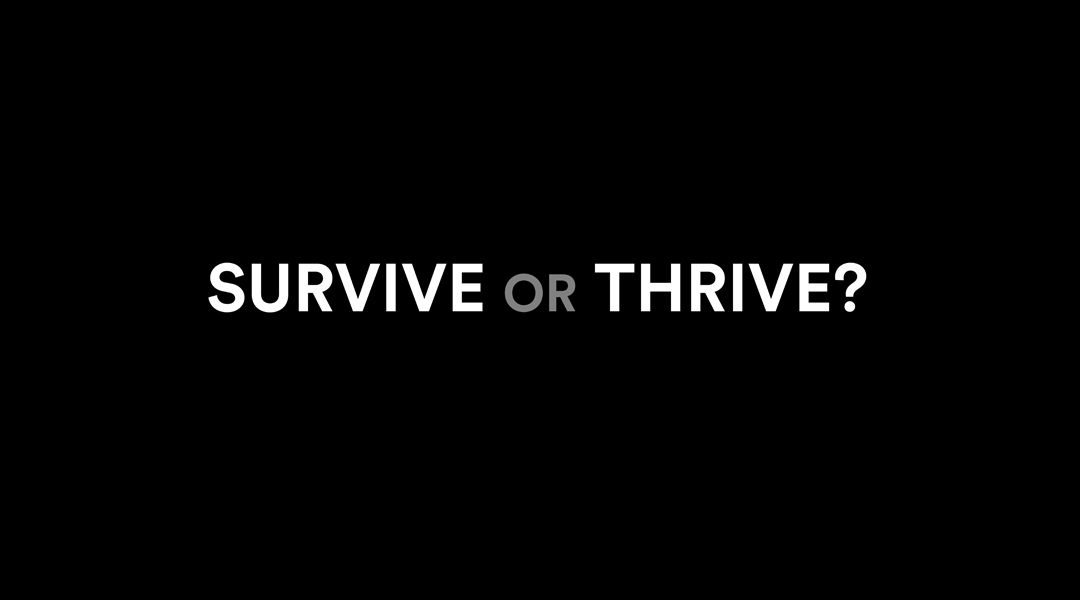
“Talking about our practice, we have to redefine and make our culture clear to everyone,” he said. As AIDEA went into the pandemic, culture was one of the things that they focused on as a firm, ensuring that their culture is transparent internally, is service-oriented or customer-centric, collaborative, and resonant with their clients’ goals. “The last transformation that we did is to convert our business from purely a design service to a design and technology practice that we believe will provide value in the future,” Tolentino ended, remaining optimistic not just for a better normal, but for a better future.
READ MORE: Tolentino’s Manifesto
What, then, would be good advice to clients?
Now that companies have resorted to working from home and businesses are operating remotely, architects and designers really have a chance to rethink the workplace: What can be improved? What designs would be beneficial even in the years to come? Christine Bruckner of M Moser Associates provided ideas and suggestions to create the “workplace of the future,” sharing how we are “embracing a workplace paradigm shift which prioritizes human health, mental wellbeing, and planetary stewardship through design and creating high-performance spaces for everybody.”

The M Moser Director selected designs from their 22 offices globally, citing these as examples throughout her presentation. According to Bruckner, the office is beginning to change now that people can work from home, but it continues to be a tool, as well as to hold the tools, to get work done efficiently. Bruckner said that a lot of people are concerned with their health and with what they can do to take care of one another. She underscored that health should be prioritized in design and that this should be done with urgency. “Meeting our human needs, connecting us to nature, helping us collaborate, strengthening our culture (as what Tolentino mentioned), bringing us together—that is what we’re looking at in the workplace of the future.”
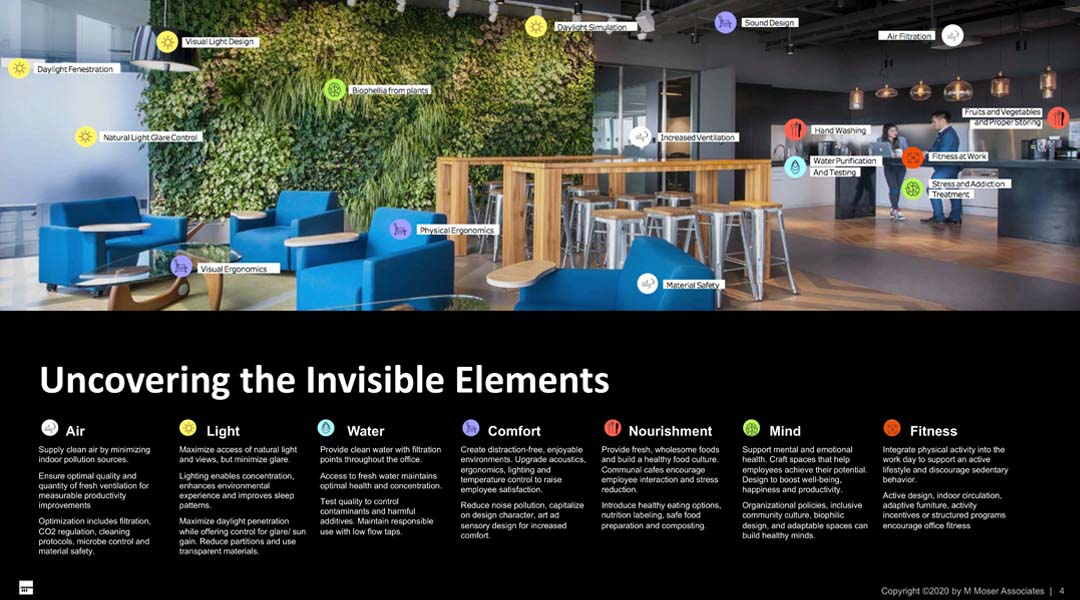
In this period of COVID-19, there is a lot of anxiety, fear, and stress. “Our brain is in fight or flight, and we are actually hurting and it’s getting in the way of our immunity,” Bruckner said. One of the areas that she focused on is ‘mind and design,’ which addresses “the opportunity to create spaces filled with biophilia, with light, with energy, and versatility.” The architect shared that these aid in stress reduction, allowing people to perform creative work in the best way possible, all through design.
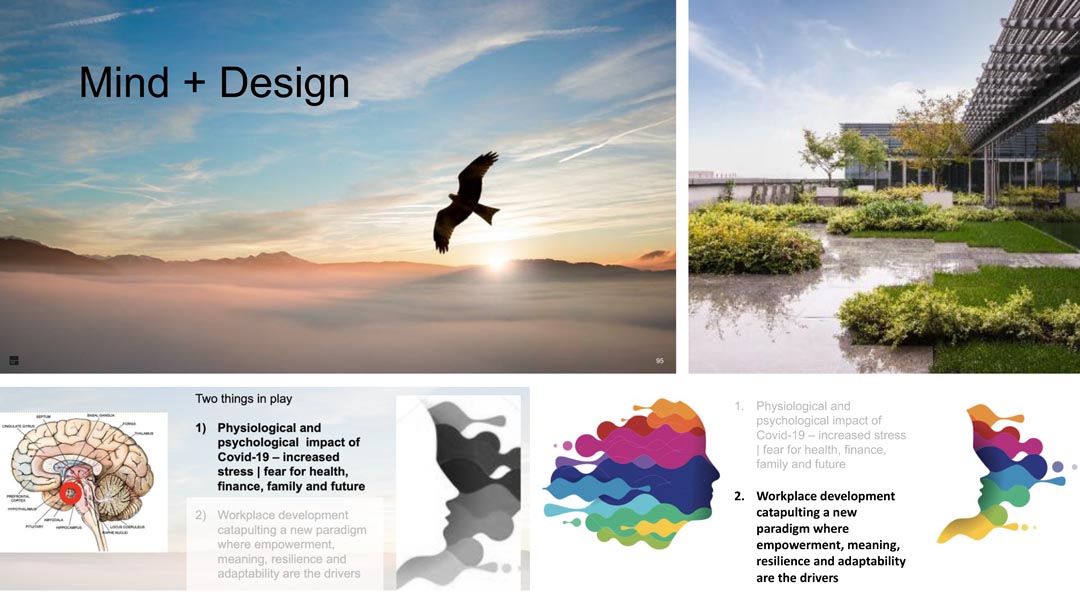
Bruckner also emphasized the importance of versatility and movement. “The idea of moving is very connected to how we think.” She said that incorporating movement incorporates a greater opportunity for creativity, which is one of the most important elements for any business to thrive. “As you change your location, you change your state, change your way of thinking, change your perspective—more things are possible.” The director shared how M Moser plays around the design of their office spaces, moving desks, creating open lounge areas, and incorporating greenery. “These are the same principles that we work with clients to create new ways of working and we’ve been doing this for decades. Now more than ever, we have an opportunity where there’s a focus on health. We really get to push that forward together.”

Rejuvenation was also one of the areas that Bruckner touched on. She emphasized that it does not take much for this to be possible, saying: “As long as somewhere in that space, people can come together, can connect to nature, can be beyond themselves, natural light can rejuvenate.” Throughout her presentation, Bruckner discussed that the importance of having healthy, natural, shared, and open spaces, is to give people a place to meditate and repose, a place to sit and chat with people, and a place to find that peace that will enable them to get back to work in a way that they want to. “Right now, we are keeping some distance when we come together, but in the future and in the past and soon to be, we’ll be coming together again to doing our best work and brainstorming and we’ll be back to those areas where we can enjoy jungle zones and sky view zones together.” Bruckner shared that all these elements can be applied even for high-rise structures, citing that the way we measure everything is essential so that even at a high level, we can look at how we can continually improve and raise the bar for everything going forward.

Towards the end of her presentation, Bruckner once again called for architects to be “relentless in the design of spaces that heal, inspire, and empower everybody.” She said that the workplace itself is a tool for the best jobs ever and that we just have to do this collectively. “Everybody’s involved. From the client to the construction team, to the designers, to the users.” She ended, “Right now, when we have this pause globally, this is an amazing time to put health, mental wellbeing, and high performance at the forefront.”
YOU MIGHT LIKE: For Christine Bruckner, ‘Build a Better Normal’ means prioritizing the wellbeing of people and the planet
More than simply surviving a crisis, the key points that each speaker presented gives hope to businesses to thrive in the ‘better normal.’ The challenge is for us to build through educated decisions, creative collaborations, and planet- and people-sensitive solutions.
Watch ‘Build A Better Normal,’ the three-part LIXIL Design DeepDive™ Live Sessions – Philippines and join the discussions. The first live session, ‘Advising Clients in a Brave New World,’ was streamed live on July 22 from 2:00 to 3:15 PM at the American Standard Facebook page.
BluPrint is the exclusive media partner of LIXIL Design DeepDive™ Live Sessions – Philippines, co-presented by LIXIL brands American Standard, GROHE, and INAX. Design DeepDive™ Live Sessions is a LIXIL Asia Pacific regional activity, with the first webinar series hosted by India and ‘Build a Better Normal’ hosted by the Philippines.


